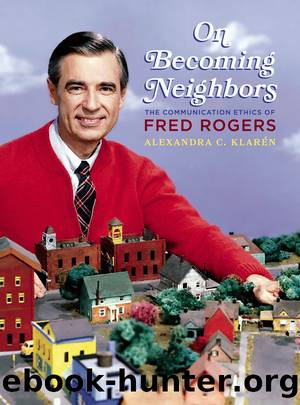On Becoming Neighbors by Alexandra Klaren

Author:Alexandra Klaren [Klarén, Alexandra C.]
Language: eng
Format: epub
ISBN: 9780822987208
Publisher: University of Pittsburgh Press
NEIGHBORHOODâS SYSTEM OF OBJECTS
When viewing the NMB segment, one does not necessarily imagine people working to create the set, its castle, tree, Museum-Go-Round, etc. with their own hands and shop-like tools. This sense that the object is the work of human hands, a preindustrial object, I would argue, exists at the visceral level of meaning in the mind of the modern viewer. It is the lack of perfection in the building assembly, along with the similarly imperfect quality of the paint job, that communicates this homemade, anthropocentric aesthetic feeling. The furniture and the objects in Rogersâs television house suggest a similar sensory field.
In the United States, however, style choices like those made by Rogers on Neighborhood carry wider cultural consequences, as they tend to highlight New England as the American âhearth zoneâ and center of the nationâs colonial beginnings from which the rest of the country derived historical and cultural lineage.56 Of course, this means obscuring the South and slavery, the history of African Americans, the development and conquest of the West, the history of American Indians, the relationship between whites and Mexicans in the Southwest, and large cities like New York and Chicago with their many working-class immigrants, as well as southern and urban opulence. In this regard, it is not surprising that Rogers, whose cultural orientation and affinity for the traditions of mainline Protestantism I have discussed, replicates a colonial revival aesthetic on his program. Indeed, Neighborhoodâs visual artifactual field signifies mainline Protestant cultural dominance.57
Rogers clearly values the feeling of authenticity produced by handmade, lived-in objects, as they nurture this perceived human craving for origins and history. Each of the sweaters Rogers wears on the program was made by his mother. The puppets in the NMB are simple, almost ragged in their appearance; they were handcrafted by people he knew. Neighborhood features the transformation of objects as they pass through the hands of people, who either transform them physically or who alter their symbolic meaning through human contact and social mobility.
In many episodes, Rogers ventures out into the community in order to visit the places where objects are made. In one popular segment, he visits a crayon factory and we see all the levels of industrial processing that turn colorized wax into crayons. I read this episode as an effort to humanize the faceless industrial factory and dehumanizing processes of industrial production. We can see Rogers trying to bring visibility to human production in the ways that the crayon factory segment illustrates the intricate mechanization steps in creating boxed crayon products. In it, he attempts to reduce the alienation between the producers of the products and its consumers. Viewers of the program watch the inner workings of machines and are shown the ways that people are involved in the process of ensuring the machineâs proper functioning and the creative process of making and packaging the crayons. Rogers seems to see the restoration of transparency in the social production and exchange of products as rewarding, and indeed pleasurable, in
Download
This site does not store any files on its server. We only index and link to content provided by other sites. Please contact the content providers to delete copyright contents if any and email us, we'll remove relevant links or contents immediately.
Whiskies (Collins Gem) by dominic roskrow(44965)
Spell It Out by David Crystal(35998)
Cecilia; Or, Memoirs of an Heiress — Volume 1 by Fanny Burney(32384)
Cecilia; Or, Memoirs of an Heiress — Volume 3 by Fanny Burney(31758)
Cecilia; Or, Memoirs of an Heiress — Volume 2 by Fanny Burney(31725)
Beautiful Disaster by McGuire Jamie(25208)
Trainspotting by Irvine Welsh(21461)
Chic & Unique Celebration Cakes by Zoe Clark(19902)
The Secret History by Donna Tartt(18767)
How High Can a Kangaroo Hop? by Jackie French(18744)
Twilight of the Idols With the Antichrist and Ecce Homo by Friedrich Nietzsche(18457)
All the Missing Girls by Megan Miranda(15415)
Cat's cradle by Kurt Vonnegut(15112)
Ready Player One by Cline Ernest(14452)
Fifty Shades Freed by E L James(13129)
For the Love of Europe by Rick Steves(12374)
4 3 2 1: A Novel by Paul Auster(12233)
Crooked Kingdom: Book 2 (Six of Crows) by Bardugo Leigh(12174)
Grundlagen Kreatives Schreiben (German Edition) by Helfferich Pia(10365)
